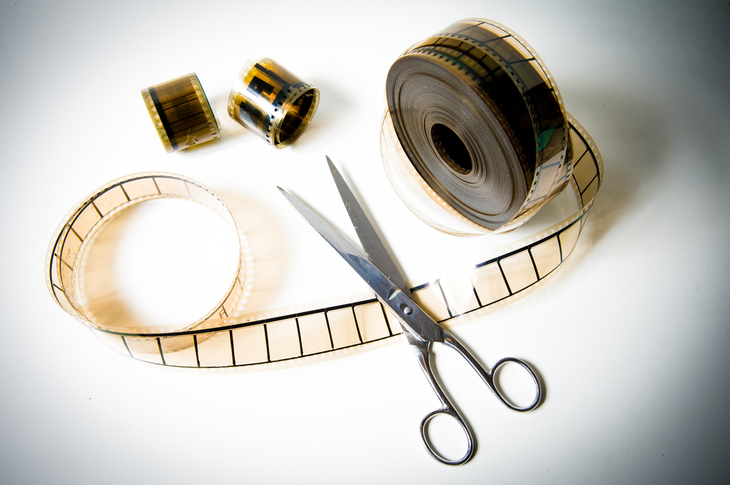
A New Key to HD? How TDP43 Might Spoil The Show
Like a movie editor removing bloopers, our cells also edit their protein machines to make films worth watching. New research finds the cell’s movie editor is distracted in Huntington’s disease.
A new study led by researchers from the University of California Irvine gives us new clues as to how genetic message molecules are edited differently in the context of Huntington’s disease (HD). Let’s get into what the scientists found and why this matters for our understanding of HD.
The cellular editor
When watching our favorite movies, we don’t typically consider the extraordinary amount of editing required to make them flow seamlessly from scene to scene. Behind this movie magic are editors who work tirelessly to enhance the drama of key plot twists with clever and precise cuts, removing unnecessary scenes and bloopers, and eventually stitching everything together to create the polished films we love.

Cells use a similar editing process when creating proteins, the molecular machines that perform nearly all the activities inside cells. Proteins are like polished feature-length films in theater and, just as movies originate from a collection of unedited scenes, proteins are also made from an unedited version called mRNA.
mRNA is a long string-like molecule with multiple “scenes” containing the genetic instructions needed to make protein. Through an important process called splicing, cells remove segments of mRNA called introns (bloopers) and keep segments called exons (key plot twists). If everything runs smoothly, the initial unedited mRNA, containing a mix of introns and exons, will have its introns removed leaving it with only exons when it is used to make proteins.
However, this editing process malfunctions in people with HD, leading to serious problems in how some of the protein machines work inside brain cells.
Cells with bloopers and missing scenes
“Splicing errors are harmful because a cell’s protein machines made from improperly spliced mRNA either function abnormally or fail to be produced altogether.”
Scientists have long suspected that mRNA splicing is disrupted in the brains of people with HD. Previous research has found introns mistakenly included in the final mRNA molecule and exons mysteriously missing. This would be like publishing movies without removing bloopers and missing critical plot twists – not something cinema-goers would be happy with!
Recent experiments suggest that the protein encoded by the gene that causes HD, called Huntingtin (HTT), may play a key role in this confusion. HTT is an mRNA-binding protein and is known to interact with other proteins that also bind mRNA. This raises an interesting question: if splicing is disrupted in HD, HTT interacts with mRNA, and HTT interacts with proteins involved in splicing, could mutant HTT be interfering with the cell’s mRNA editing process?
Blockbuster bombs in the cell
Intrigued by this mystery, Dr. Leslie Thompson and her team at the University of California Irvine investigated the underlying cause of splicing errors. Using mouse models of HD and post-mortem human brains, they first confirmed that splicing is disrupted in the HD brain, discovering various types of mRNA with undeleted introns (bloopers) and missing exons (key scenes). These errors were most common in the medium spiny neurons, the type of brain cell that is most vulnerable in HD. In addition, the mRNA message molecules that were found to contain splicing errors were particularly important for activities like neural communication and brain development.

Image credit: MIKI Yoshihito
Splicing errors are harmful because a cell’s protein machines made from improperly spliced mRNA either function abnormally or fail to be produced altogether. This would be like a movie so poorly edited that the publisher decides to pull it before hitting theaters.
These findings are exciting for HD researchers because they may explain why some proteins don’t work very well or are less abundant in HD cells, despite having no mutation or known interaction with HTT. Although the consequences of splicing errors are complex and difficult to predict, they are undoubtedly harmful to overall brain function.
TDP43: A distracted editor
Leslie and her team scrutinized the proteins interacting with HTT in search of possible causes of the splicing errors. They focused on proteins that, like HTT, also interact with mRNA – like partners in crime.
“These findings are exciting for HD researchers because they may explain why some proteins don’t work very well or are less abundant in HD cells, despite having no mutation or known interaction with HTT.”
One protein, TDP43, stood out because it not only interacts with HTT and mRNA but is also known as a kind of splicing editor-in-chief. TDP43 is an extensively studied protein because its mutation causes a different neurodegenerative disease, Amyotrophic Lateral Sclerosis (ALS), so researchers already have a great profile on it. Adding to their suspicion, the types of mRNA that TDP43 is known to edit closely overlap with the mRNA containing splicing errors in HD.
Beginning their investigation of TDP43, Leslie and her team first tested if TDP43 binds to the same mRNA that is spliced incorrectly in HD. Sure enough, they found that TDP43’s favorite mRNA largely overlapped with the abnormally spliced mRNA in HD. When researchers compared the splicing changes of cells missing TDP43 to cells containing mutant HTT, they observed remarkable similarities. This suggests that TDP43 dysfunction might be the root cause of splicing errors in HD.
How HTT spoils the show
The team hypothesized that HTT’s interaction with TDP43 could be “stealing” it from the studio, and preventing it from splicing mRNA. To test this, they first confirmed that HTT interacts with TDP43 in mouse brains. Next, they examined brain cells from people with HD to see if TDP43 was in its normal location, the nucleus, where splicing occurs. Like an absent movie editor, TDP43 was mostly located outside of the nucleus, a clear indication that something was wrong.

Scientists have long recognized changes in TDP43 location from the nucleus to the cytoplasm (outside the nucleus) as a hallmark of ALS, and this change in location is associated with errors in splicing. What’s worse, the small amount of TDP43 still in the nucleus appeared inactive because it was locked up in big protein clumps with HTT, like an editor buried by movie reels!
Another red flag the scientists noticed was the absence of special chemical markings on mRNA, called m6A, that guide TDP43 to splice sites, like sticky notes reminding the editor to delete certain scenes. These chemical markings on mRNA were significantly reduced in HD brains, particularly on mRNA prone to splicing errors. Without these marks, TDP43 is unable to identify the “bloopers” it needs to remove and likely contributes to TDP43’s dysfunction.
At this point, the researcher’s working hypothesis was that mutant HTT abnormally interacts with TDP43, keeping it out of the nucleus or trapping it in large clumps, distracting it from its splicing duties. On top of this, the sticky notes (m6A marks) that guide TDP43 to the bloopers (introns) were mostly missing in HD brains. Together, these issues prevent mRNA from being properly edited, resulting in broken or missing protein machines. Over time, these problems lead to sick brain cells that can’t communicate properly.
Putting the editor back to work
Although the current study does not attempt to correct or reverse these splicing errors, its findings will help guide future therapeutics. The involvement of TDP43 is particularly interesting because TDP43 is already extensively studied in ALS, and hundreds of TDP43-targeting therapies are currently in development. This does not necessarily mean treatments designed for TDP43 will work for HD, but they may serve as promising starting points for new therapeutic strategies or to help us better understand what TDP43 is doing in HD.
Future research is critical to understanding how mutant HTT disrupts TDP43 activity, and whether restoring TDP43 activity can correct the splicing errors observed in HD. Like editing a movie, fixing these molecular errors could turn a blockbuster disaster into a beloved masterpiece we cherish for years to come.
Learn more
For more information about our disclosure policy see our FAQ…


